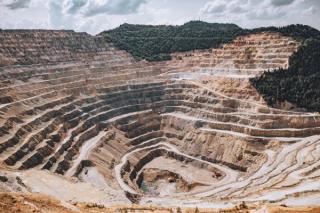
Unearthing ESG Value: Scalable solutions for mining projects from exploration to closure
by Michelle Gluck, Jim McKinley
View post

In this article, the first in a series on geology’s ability to help us address the climate crisis, Paul Gordon & Nick O'Neill look at the opportunities and challenges with underground storage.
The most recent IPCC report (Climate Change 2022: Mitigation of Climate Change) makes it starkly clear that humanity has less than a decade to keep the global temperature rise below 1.5°C. Given that these reports are published approximately every six years, it is likely that by the time the next one is out, we will either have passed the point of no return, or we’ll be slowly clawing back the damage. Renewable energy has an enormous role to play in this transition. While CO2 production must be dramatically reduced, some is unavoidable, and we will have to deal with that.
We often think of geological resources in terms of raw materials that can be extracted, but storage as a resource is increasingly important and will play a key role in reducing CO2 emissions to the atmosphere and enabling renewable energy.
Geological storage can be used as a temporary way of storing energy for later use. Batteries are typically capable of storing energy for hours, whereas geological storage has the potential to store energy for days or weeks. One of the biggest challenges with renewable energy use, particularly wind and solar, is smoothing out electricity production. For example, what do we do when the wind is so strong that it’s producing more power than we need? Or, where does our power come from when the solar panels are not producing? We can’t make the wind blow at a nice steady pace whenever we want it, nor can we make the sun shine at night. Currently, renewable energy suppliers are forced to reduce their electricity production at times when supply exceeds demand, a process known as curtailment.
The better answer is to store excess energy and release it when it’s needed. Converting excess power into something that can be stored underground is one option.
Underground Hydrogen Storage (UHS) has already been established as a viable technology and it is set to grow, in line with the development of hydrogen as a means of providing storable, transportable energy. Hydrogen is 100% clean when burned, with water the only by-product. Hydrogen can produce high-grade heat (>400°C) so it has industrial as well as energy generation uses. One of the biggest challenges is in finding suitable places for storage; depleted Oil and Gas reservoirs, salt mines and deep saline aquifers are all potential options for geological storage of hydrogen.
Hydrogen can come from one of two sources.
Compressed Air Energy Storage (CAES) uses excess power to store energy as compressed air, so that it can be used later to generate electricity. Like UHS, CAES has the potential to mitigate the issue of inconsistent supply with some renewables. Excess power is used to run a compressor, which draws in air, compresses it and pumps it to a sealed, underground chamber. Pre-existing underground voids, such as salt mines, can be used, but one project in California intends to create its own cavern. When it’s needed, the compressed air is released from the underground storage and used to drive turbines, generating electricity. When the air is compressed, it cools down, with heat as a by-product. When energy is being recovered from the compressed air, it must first be heated again, so the most efficient systems will store and use the by-product heat from the compression phase.
Carbon Capture, Utilisation and Storage (CCUS) is an area where the Industrial and Oil & Gas sectors can collaborate, to the benefit of both. For Industry, it’s a way of reducing CO2 emissions to the atmosphere, and for Oil & Gas, it’s a way of turning depleted reservoirs into CO2 storage systems.
But how does it work? Carbon is captured using one of a range of techniques, with chemical adsorption being the most widely used, there are several more methods in development, at varying stages of readiness. The captured CO2 is mainly transported by pipeline, although ship, rail and road are also possible. The CO2 is then injected into the host reservoir, which can be a depleted Oil and Gas reservoir, or another type of geological trap. Depleted reservoirs are particularly attractive as they have already demonstrated that they can store fluids. The captured CO2 needs to be stored at a depth of at least c. 800m, where it behaves more like a liquid than a gas and is therefore less likely to migrate upwards through the reservoir. A particularly exciting development is the Northern Lights development, which will offer permanent carbon storage to any European industry, in the Norwegian offshore. SLR sees this as an area that will develop rapidly in the coming years, and one that has genuine potential, particularly for large point emitters of CO2.
On a final note, it is worth commenting that there is competition for geological space. Underground mining operations are increasingly under pressure to significantly reduce their tailings facilities by increasing the amount of non-metal bearing rock they put back underground. That is extremely important in many cases, as surface tailings can pose a threat to life and the environment if not designed and managed properly. This, however, brings up another question: is backfilling with tailings always the best use of underground space?
Geological storage continues to evolve and there are increasing options for underground space usage, where previously there may have been none, or only one. The industrial, energy and natural resources sectors need to come together to maximise these resources. We are facing something that is almost unimaginably serious, and it is time to not only consider all the options, but to start using them.
If you’d like to find out more, please contact us.

by Michelle Gluck, Jim McKinley

